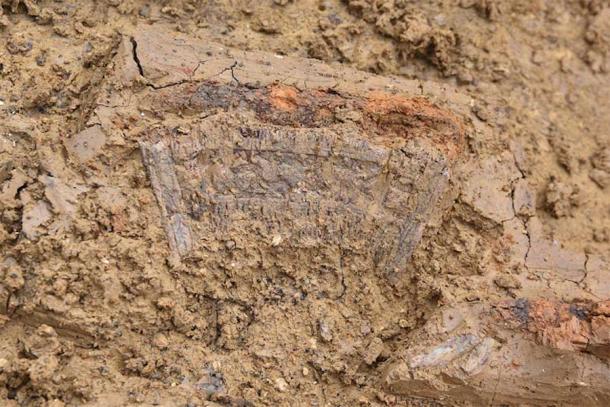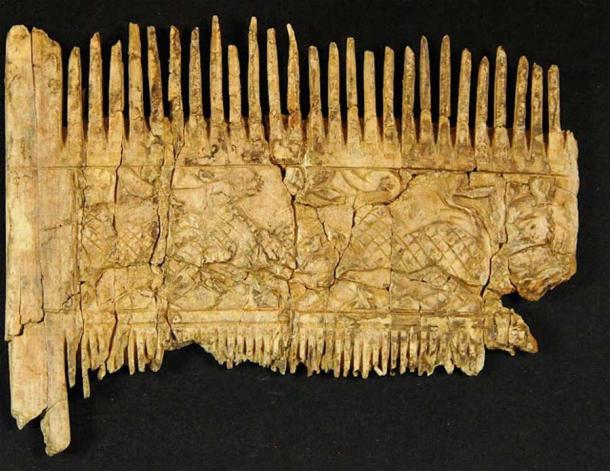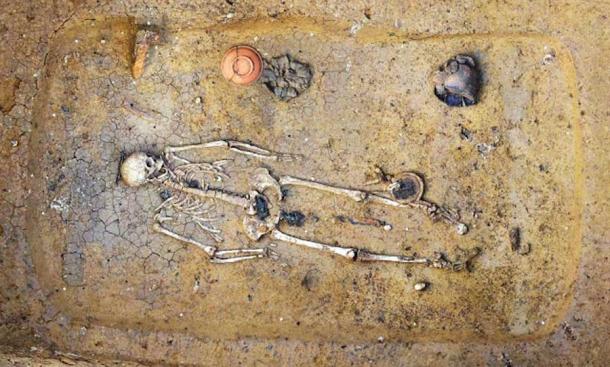Rare Artifacts Found in Two 6th Century Bavarian Graves in Germany
Two Bavarian graves unearthed during excavations in the southern German town of Deiningen have generated exceptional interest among archaeologists. The two graves were in excellent condition when found and both of them contained an extremely unusual artifact. One of the graves contained a carved ivory comb. In the other, a red ceramic bowl from ancient Tunisia was identified. Archaeology News Network quotes the Bavarian State Office for the Preservation of Monuments (BLfD), as saying that north of the alps these two finds are unprecedented.

The carved ivory comb as it was found in one of the two Bavarian graves. (Archaeological Office Dr. Woidich GmbH)
The Rare Ivory Comb in one of the Bavarians Graves
The unusual Bavarian graves were discovered during an excavation at the site of a new municipal construction site in the town of Deiningen, which is located in the Nördlinger Ries region of western Bavaria. More than 75 graves have been discovered at the site during ongoing excavations, including one double grave of a young man and a young woman buried holding hands. These sixth-century AD graves in an organized burial site have caused a rethink about the history of Deiningen, which was previously believed to have developed in the 8th century AD.
- The Enigmatic Erdstall Tunnels of Europe: Purpose - Unknown
- A Storybook Setting: The Famous German Fairytale Castle of Neuschwanstein
The carved ivory comb was found in the grave of an adult male who was 40 to 50 years old at the time of his death. The other artifacts recovered from his grave reveal that he must have been an important person, most likely a high-ranking soldier. He was buried with a full set of arms including a sword, a lance, a battle axe, and a shield. The skeletal remains of a horse were found in a pit next to him. Remains of a pair of spurs and a bridle found in his grave indicate that the horse belonged to him. A bronze basin was also found in his grave.
But it is the ivory comb, decorated on both sides, found together with a pair of scissors in a decomposed bag made of organic material that begs explanation. The bag was a sixth-century-AD version of a toiletry bag, and the comb and scissors were used to groom the man’s beard.

The front of the restored carved ivory comb found in one of the Bavarian graves at the Deiningen grave excavation site. (BLfD)
However, the comb is an extraordinary find on several counts. To begin with, combs were only included as burial goods later in the medieval period. They were generally carved from wood, animal bone or antler rather than ivory. In fact, ivory goods of any kind are extremely atypical of the sixth century AD. The hunting motif on the comb too is an uncommon departure from the Biblical scenes that were usually carved on such combs. At 5.5 inches (13.9 centimeters) in length the comb is also bigger than most combs found in graves from the early medieval period.
The comb was found in several pieces. Careful restoration work by conservators from the Bavarian State Office for the Preservation of Monuments resulted in a reassembled comb. The carving on the comb is very fine. On both sides, gazelle-like creatures are depicted leaping away from predators. Clearly the scene is a non-European one, but exact identification of the species and whether it depicts African animals cannot be claimed with certainty.
Highlighting the rarity of the find Johann Friedrich Tolksdorf, the archaeologist in charge at the Bavarian State Office for the Preservation of Monuments said "Comparable depictions on a comb from this period have not come down to us so far. This makes this find not only an outstanding archaeological but also an important historical art source," reports Archaeology News Network.

The woman’s 6th-century Bavarian grave contained a ceramic vessel from ancient Tunisia. (Archaeological Office Dr. Woidich GmbH)
The Second Bavarian Grave and a Bowl for the Afterlife
The second Bavarian grave was that of a woman around 30 to 40 years of age at the time of her death. She was buried along with jewelry, vessels, food, and a weaving tool. Locally made ceramic utensils were also found buried in the grave. But to the left of her left elbow was a red ceramic bowl that is an example of high-quality African slipware. This kind of ceramic ware was produced in the territory of what is now Tunisia from the 1st to the 7th century AD and was traded throughout the Mediterranean. This is the first example in such complete condition found in Germany.
Broken cleanly in two but complete, the inside of the bowl was stamped with a cross at the time of production. More intriguingly, the rim of the bowl has script-like symbols scratched on it. Whether they were doodles, name signs, religious or magical symbols. Maybe the message was written in runic alphabets still common in the area despite the adoption of the Latin alphabet. This is a question that is up for speculation, as is the meaning of the letter-like etchings.
- Ludwig II of Bavaria: Suicide or Murder? How Did the Swan King Meet His End?
- The Man Who Started The Illuminati and His Thwarted Promotion of The Enlightenment
How the ivory comb and Tunisian ceramic vessel found their way to Bavaria, which was populated by the Alemanni, a confederation of Germanic-speaking tribes in the upper Rhine River region, can also only be answered by guesswork. They could have been gifts from a ruler to a follower, tribute, war loot, or perhaps they represent something entirely different.
Top image: Of the two unusual Bavarian graves, this one was of a 40- to 50-year-old man buried with his horse and a carved ivory comb for beard grooming. Source: Archaeological Office Dr. Woidich GmbH
By Sahir Pandey
References
ANN. 2021. Two richly furnished graves from 6th century unearthed in Bavaria. Available at: https://archaeologynewsnetwork.blogspot.com/2021/10/two-richly-furnished-graves-from-6th.html
Der Standard. 2021. Bayern: Kostbarer Elfenbeinkamm aus dem 6. Jahrhundert entdeckt. Available at: https://www.derstandard.at/story/2000130123266/bayern-einzigartiger-elfenbeinkamm-aus-dem-6-jahrhundert-entdeckt
History Blog. 2021. Unique 6th c. ivory comb found in Bavaria. Available at: http://www.thehistoryblog.com/archives/62387




















Comments
Interesting are you saying these were living beings hunted down under the guise of archeology? Never thought of that possibility?
Deonte N. Ferino